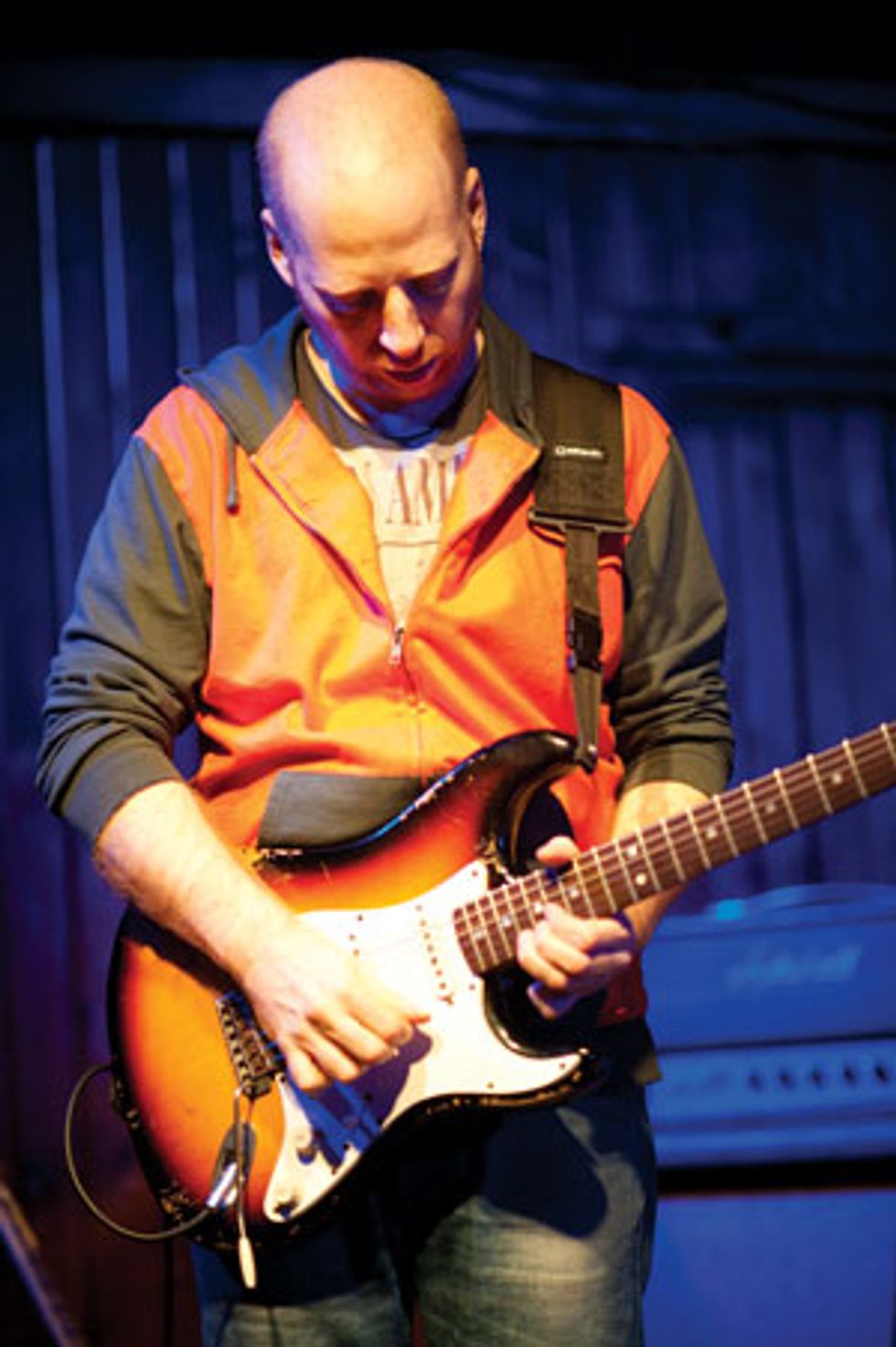
Listen to a track from Twisted Blues, Volume 1:
Back in the early ’80s, Brand X bassist Percy Jones debuted a trio at New York’s Bitter End nightclub featuring the then-unknown Bill Frisell. Soon after, Frisell became recognized as one of the most original electric guitarists of all time. Two decades later, history repeated itself when Will Lee and Anton Fig—the famous rhythm section from The Late Show with David Letterman—began to appear at the same club accompanying another unknown but truly original guitarist: Oz Noy.
Imagine a player with the combination of Jimi Hendrix’s sonic adventurousness, Jeff Beck’s wit, John Scofield’s harmonic sophistication, Yngwie Malmsteen’s chops, and Stevie Ray Vaughan’s tone. Now imagine that player writing and performing music as funky as James Brown and the Meters.
By age 13, Oz Noy was doing sessions in his native Israel. By 24, he had accompanied a slew of famous Israeli artists, many during a two-year stint as a member of a television show’s house band. Emigrating to New York City in 1996, he soon earned the respect of the city’s best musicians, becoming a fixture on the highly competitive session scene. To date, Noy has recorded five solo records. His first, 2006’s Live, reflects the excitement of his weekly club gig at the Bitter End. On his latest, Twisted Blues, Vol. 1, Noy is assisted by the likes of Eric Johnson and Allen Toussaint as he pays tribute to one of the musical forms central to his artistry. The original title tune recalls cool theme music from a ’70s cop show, while his takes on the Thelonious Monk tunes “Light Blue” and “Trinkel Tinkel” exude tikibar and Texas-shuffle vibes, respectively.
Noy’s singular, spectacular style invites endless raving from his contemporaries—just read the “Others on Oz” sidebar on p.180—but let’s hear from the man himself first.
You started playing guitar
when you were 10. Did
you start taking lessons
immediately?
Yes. I started playing chords,
Beatles songs, and Israeli songs.
There were Beatles records in
the house, and then my brother
started bringing home jazz
records. I began with the electric
stuff—Pat Metheny, John
Scofield, Allan Holdsworth, and
Scott Henderson. I went to a
teacher who said, “If you want
to play like that, you have to
learn the roots—bebop.” My
whole thing comes from bebop.
How old were you at that point?
I was 15 or 16 when I started to
concentrate on bebop. I played
with my thumb for years—I was a
Wes Montgomery clone. I learned
a lot of Charlie Parker, Bud
Powell, and Thelonious Monk.
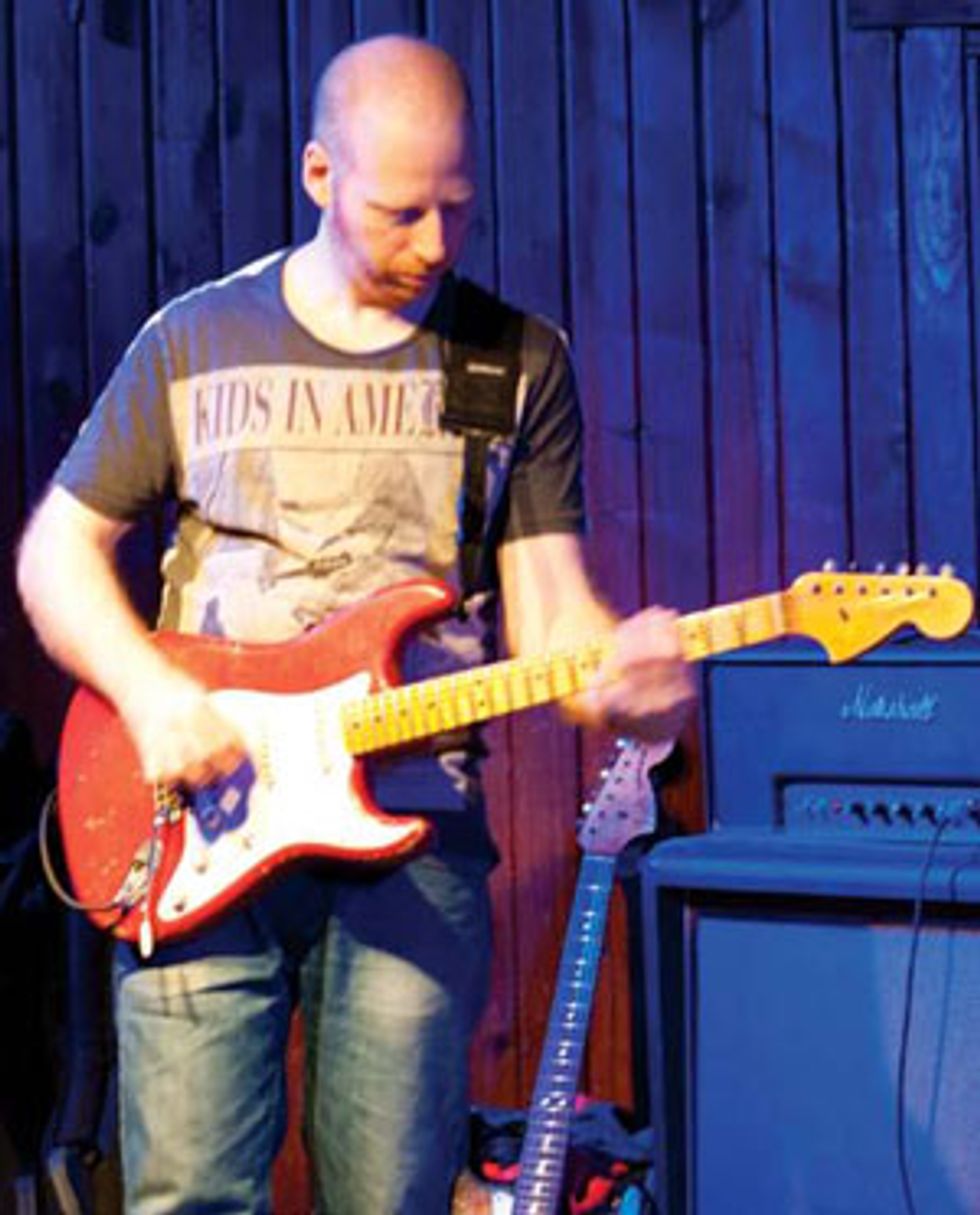
Noy onstage with his two Fender Custom Shop 1968 Strat Relics, both of which feature ’70s-style headstocks.
What were you playing on
back then?
First, I had a copy of a Gibson
L5, then a real Gibson ES-175.
At the same time, I had a
Charvel and was playing heavy
metal—because I was growing
up in the ’80s [laughs].
My friends used to ask me,
“When are you going to decide
[which style to stick with]?” I
couldn’t—I liked both.
In the early ’90s, I discovered Stevie Ray Vaughan. That led me to Hendrix. I started to understand that, in order to sound anything like those guys, I had to get more into the blues. I began to get away from bebop and into people like Jim Hall and John Coltrane, which opened it up a little more. It became less of a strict separation between bebop and metal.
Because the blues is closer to
jazz than metal?
Exactly.
How did your current
style evolve?
In Israel, I used to do jazz gigs
and a lot of recording with pop
artists. At one point, I wasn’t
getting many calls to do jazz
gigs, so I became a bandleader.
At first, I would do all Wes
Montgomery, but once I decided
to do a real electric thing I
got a trio and we would play
Stevie Ray Vaughan-style stuff.
But, instrumentally, I got bored
after a few months of that. So
I added instrumental versions
of Stevie Wonder and James
Brown tunes. Then I got bored
again, because I was restricting
myself to the basic blues vocabulary.
I thought, “What would
happen if I just started playing
some of my bebop stuff over it?”
That’s when it all came together:
I had my electric rock sound,
the grooves weren’t really swing,
and I was playing a mix of any
style I wanted to—whether it
was rock, bebop, or whatever.
That is still basically the concept
of the band to this day.
When I came to New York, I brought my hollowbody guitar and my 1962 reissue Stratocaster. I always hated the sound of the hollowbody jazz guitar, even when I was heavily into Wes—it’s not as expressive as a Stratocaster. I was playing with pop artist Gavin DeGraw and needed an acoustic guitar, so I sold the hollowbody to buy one. That was best move I ever made: I only had my Strat, and I decided I was going to play all my music on that.
 At this December 2010 gig at the Saxon Club in Austin, Noy was joined onstage by Chris Layton (drums), Roscoe Beck (bass), and Reese Wynans (keys).
At this December 2010 gig at the Saxon Club in Austin, Noy was joined onstage by Chris Layton (drums), Roscoe Beck (bass), and Reese Wynans (keys).When did you get into effects?
I was always into sounds. I used to
have racks in the ’80s, but I really
started to get into effects after I
started writing my own music.
When did you start writing
your own tunes?
I was writing in Israel. Then
I started to write for my band
here. I was playing at the Bitter
End about twice a month until
after I recorded my first record
in 2001, then I started playing
there every week.
That was some band: Will Lee
and Anton Fig.
I got introduced to Anton at
this musician’s hangout, The
Bar Bat. Anton and Keith
Carlock [Sting, Steely Dan]
played drums with me from
the beginning. Bassist Reggie
Washington [Branford Marsalis,
D’Angelo] played on most of
the first album. I knew Will Lee
a little. He saw me at a gig and
said, “Why don’t you call me
to play your gig?” I had always
wanted to call him, but hey—
he was Will Lee! Then Reggie
couldn’t make a gig, so I called
Will and that was it. Until now,
it has been pretty much Will
and Anton, or James Genus
[Saturday Night Live] and
Keith Carlock. Now and then,
I might change the drummer or
add an organ.
On this record, you’ve added
Vinnie Colaiuta [Sting, Jeff
Beck], Chris Layton [Double
Trouble], and Roscoe Beck
[Robben Ford, Leonard
Cohen]. How do you decide
which rhythm section is right
for each tune?
I play in Austin a few times a
year, and Roscoe is in the band
I use down there, so he knows
the material. I figured, if I was
going to record there, maybe I
could get Chris for the shuffle
tunes, so I called him and he
was totally down with it.
Do you use Chris Layton
when you play in Austin?
No, Chris was new. But it is
pretty simple stuff—I mean,
Chris knows how to play a
shuffle [laughs].
Did you go to Austin to
record Eric Johnson’s parts?
I recorded half the record
in New York at the Carriage
House, and half in Austin at
Eric’s studio.
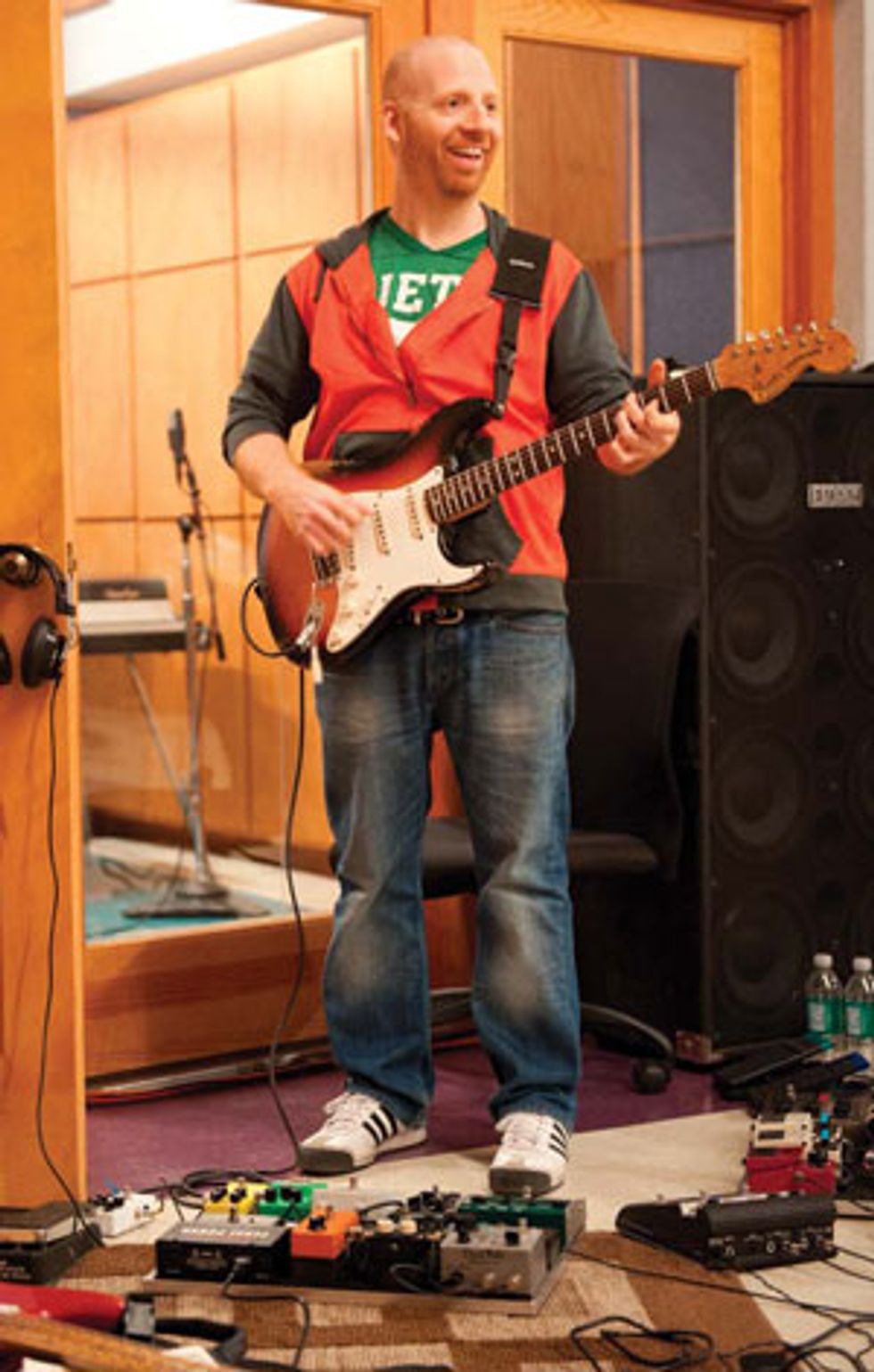
Noy having a blast in the studio with a pedalboard that barely has enough spare room to route patch cables between stompboxes.
What is Eric Johnson playing
on “You Are the State?”
He does some harmonics. At the
end, he plays a couple of lines—
some pedal-steel sounds and
textures behind me. There was
supposed to be another song
with us really playing together,
but it fell through. It will hopefully
be on the next record.
Why did you decide to call the
record Twisted Blues?
This is not a blues band, but it
takes some of the blues forms
and adjusts them to what I
do. I always play jazz. When I
improvise, I don’t think about
what I am doing, stylistically.
Even if I play with a fuzz pedal
or play a Hendrix lick, it is
still improvising jazz. The only
difference is that we don’t play
swing—we play grooves—but
the improvisation part is jazz.
For this record, I wanted to play
more blues forms, like shuffles,
and use a blues sound.
Which Strats did you use on
this album?
I have two 1968 Relic Strats
from the Fender Custom Shop.
I told them exactly what to
make, and they are fantastic. I
mostly used the red one with a
maple fingerboard. I used the
sunburst-finished, rosewoodfingerboard
one for “Trinkle
Tinkle.” I also used a Tele.
Is this the first time you’ve
played a Telecaster on record?
Yeah. It’s a ’58 Fender
Custom Shop.
You’ve been playing a Les Paul
a little these days, too, right?
I didn’t use it on the record, but
yeah, I just wanted to have a
Les Paul. I hadn’t played humbuckers
in years. For a while,
it was difficult to play, because
it reacts so differently and is so
loud. It took a while to get used
to it, but now I am digging it.
You usually record as a trio.
What made you decide to add
organ to this record?
It felt to me like it needed a
little more harmony. Plus, organ
is very bluesy [laughs].
 Noy tracking Twisted Blues, Vol.1 in Eric Johnson’s studio with Wynans, Beck, and Layton.
Noy tracking Twisted Blues, Vol.1 in Eric Johnson’s studio with Wynans, Beck, and Layton.How do you compose
your tunes?
I come up with a riff or a
concept that starts from a drum
groove. I might take a twochord
vamp or a line and record
it with a very basic groove and
bass line at my apartment in
Pro Tools. If that works, then
I write over it. For example, I
wanted to write a rhumba, and
that became “Oh Really?” I
wanted “Twisted Blues” to be
funky, and “Whole Tone Blues”
was going to be a shuffle.
I wrote the title track over one of my favorite tunes of all time—“Twisted Blues” by Wes Montgomery. I’ve wanted to write something over that form for a long time. I changed some of the chords and the melody, but the form is similar. I also did that on my other records. On Fuzzy, there is a song called “EpistroFunk” that’s based on Monk’s “Epistrophy.” There are a lot of tunes where I take the form of another song and write something over it.
When you record live with a
rhythm section, do you record
the solos live, too?
Everything is live—like the
classic jazz records. We go in
and try to play together as well
as we play in clubs. Before we
record, we play the music live
for at least a year.
What’s on your pedalboard
these days?
On the right side we have an
old Vox wah-wah going into a
Dunlop Jimi Hendrix Octavia.
Then I have the Xotic AC
Booster—I left it on for a lot
of the record. The Ibanez Tube
Screamer is for the twangier
stuff, like “Whole Tone Blues”
or “Trinkle Tinkle”—the real
Texas-flavored stuff. Then I
have an E.W.S. Fuzzy Drive,
which is great. It’s a mix
between a fuzz and an overdrive.
I used it for slide parts
and on “Two Centers.” You can
get a lot of sounds by adjusting
your guitar volume—it cleans
up nicely. Then I have a DLS
RotoSIM, an old MXR Phase
90, a Monster Effects Swamp-
Thang tremolo, then a Fulltone
Mini DejáVibe. On my second
pedalboard, I always have a slap
delay going on one of my three
Boss DD-7s, a reverse delay
on another, and a longer delay
with a single repeat on the
third. When I solo, I have the
slap delay and the longer one
with a single repeat on. When I
play the softer stuff or ballads,
I add the Electro-Harmonix
Memory Man.
I also have a Line 6 M9, mostly for looping, but also for reverse delays where I need to tap in the tempo. I need it, too, for the Sweep Echo effect that only Line 6 delays have—I use that effect all the time for psychedelic sounds. I use two expression pedals to control the volume of the delay or loop. I also have a switch to put the tuner into the chain.
You used to use the Hughes &;
Kettner Rotosphere for rotary-speaker
sounds, right?
On the recording, I used the
Hughes & Kettner but I use a
DLS RotoSIM on my pedalboard.
Which amps are you using?
I have a 1967 Fender
Bandmaster that has been
modified by Ziv Nagari. He
put in the right capacitors and
some other stuff that brought
it back to life. He also added a
high-end switch so that when I
play loud, the high end doesn’t
go away like it does on stock
Bandmasters. I also use a 1973
50-watt Marshall that Ziv just
cleaned up. For the Marshall,
I use a Bad Cat 4x12 cabinet
with Celestion Greenbacks,
and for the Bandmaster I have
a Bad Cat 2x12 with Celestion
Vintage 30s.
Do you use the amps together?
Live, I usually use either/or—
the Bandmaster works better
with the blues band. On record,
I use both together. I was never
satisfied with just one. I run
two lines from the M9’s stereo
outputs. In Austin, I used a
’60s Fender Super Reverb that
I borrowed from a friend, and
one of Eric Johnson’s Marshall
1969 50-watt plexis with one of
his cabinets.
What did you mic them with?
I had a Shure SM57 and a Royer
121 ribbon mic on each cabinet,
and I used Neumann U 87s or
AKG C 414s for room mics.
Were you able to separate your
amp sound from the band
while playing live in the studio?
Both studios had places to separate
the amp. To get my sound,
I need to move air and be near
the amp, so I usually leave the
door to the amp room open,
stand near it, and play really
loud—which causes leakage into
the drum mics. There is no way
around it: If I don’t move air, I
can’t get any sustain because I
don’t use a lot of distortion.
Does that make it hard to do
fixes and overdubs?
We don’t do fixes, we just do
five or six takes of each song
to a click track, then I take it
home and edit the best sections
of each take together.
Everything you hear was played
live together, but the B part
might be from a different take.
How did Allen Toussaint end
up on the record?
I originally meant to have a
piano on “Oh Really?” and it
was sounding a little weak without
it. Allen had come to some
of my shows—he’s a friend of
Will Lee’s.
 Noy’s amps are isolated to minimize mic leakage as he tracks live with the band, but he stands by the cracked-open iso-room door to facilitate
volume-driven sustain.
Noy’s amps are isolated to minimize mic leakage as he tracks live with the band, but he stands by the cracked-open iso-room door to facilitate
volume-driven sustain.Did he overdub his parts?
Yes. He came so prepared—
believe it or not, he had transcribed
my whole guitar solo!
“Light Blue” introduces slide
playing to your repertoire.
Did you set the guitar up differently
for that?
No. I played it on the red Custom
Shop Stratocaster that I used for
most of the record. The action
was a little low, but I managed.
Is it in standard tuning?
Yes, but a half-step down. I usually
use .011s with a .012 high
E, but when I tune down I use
.012 sets and a .013 high E.
How did the double-time part
on “Steroids” evolve?
On the Live record, it was really
fast but as we continued to play
it live, it became more medium
tempo. The B section wasn’t
sounding right, so we sped it
up to double-time.
Why did you decide to re-record
“Cissy Strut” [which was also on
Noy’s 2006 album Oz Live]?
The Live record was done with
just one stereo mic. I wanted to
get a better recording, and it fits
with the blues record.
Is it in an odd time signature?
It is in 4/4. I moved some of
the lines and shifted some of the
melody parts over, but if you listen
to the drums they are in four.
That’s the twisted factor [laughs].
Is that a ring modulator or octave
fuzz over the beginning loop?
It’s an octave fuzz.
Is there going to be a Twisted
Blues, Vol. 2?
Absolutely!
Oz Noy's Gear
Guitars
Two Fender Custom Shop 1968 Relic
Stratocasters, Fender Custom Shop 1958
Telecaster, Gibson Les Paul
Effects
Vox wah-wah,Dunlop Jimi Hendrix
Octavia, Xotic AC Booster, Ibanez TS808
Tube Screamer, E.W.S. Fuzzy Drive, DLS
RotoSIM, Hugh & Kettner Rotosphere,
MXR Phase 90, Monster Effects Swamp-
Thang, Fulltone Mini DejáVibe, three Boss
DD-7 Digital Delays, Electro-Harmonix
Memory Man, Line 6 M9
Amps
1967 Fender Bandmaster driving a Bad
Cat 2x12 with Celestion Vintage 30s, 1973
50-watt Marshall head driving a Bad Cat
4x12 with Celestion Greenbacks
Strings and Picks
D’Addarios gauged .012, .014, .018, .028,
.038, .048 for standard tuning, D’Addario
.012 sets with a .049 on bottom (half-stepdown
tuning), Jim Dunlop 2 mm picks
OTHERS ON OZ
Oz Noy is fortunate enough to get the support of players who are more likely to work with high-paying legends than up-and-comers on a budget. In addition to the A-list players on Twisted Blues, Vol. 1—including Eric Johnson, Chris Layton, Roscoe Beck, Reese Wynans, Vinnie Colaiuta, Anton Fig, Will Lee, John Medeski, and Allen Toussaint—his trio has included drummers Dave Weckl (Chick Corea) and Mike Clark (Herbie Hancock), and bassists Jimmie Johnson (James Taylor, Allan Holdsworth) and James Genus (Michael Brecker, Herbie Hancock). We asked some of the players who’ve shared the stage and studio with Noy to talk about what lures them into working with him.
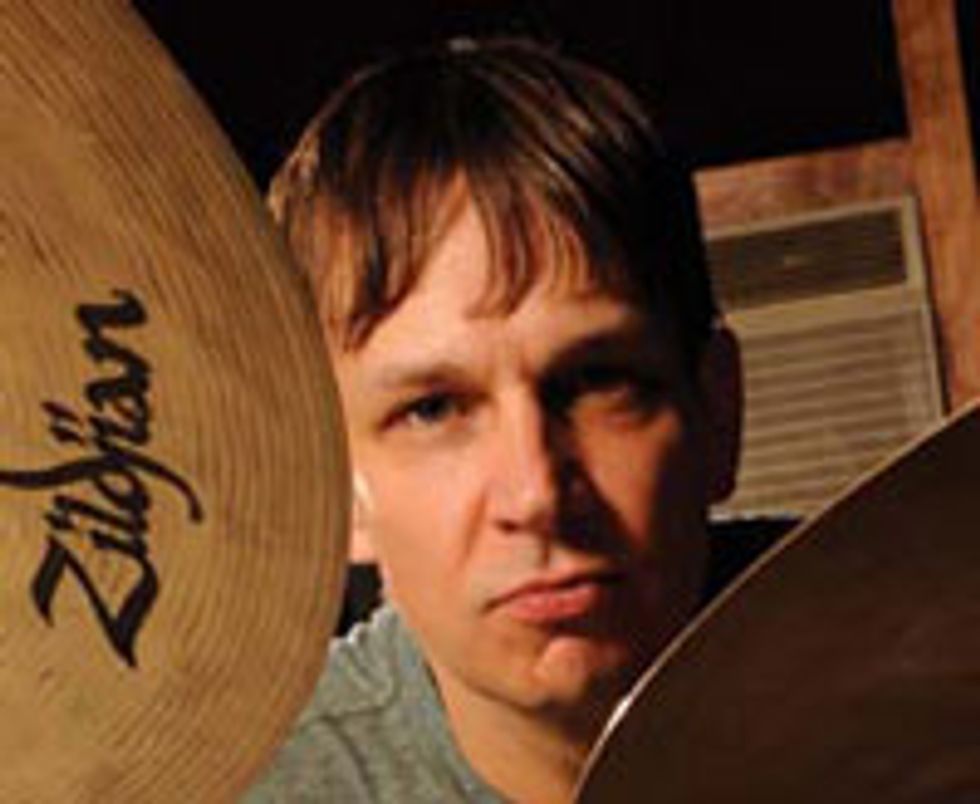
Keith Carlock
Session drummer (Steely Dan, Sting, Wayne Krantz)
“Oz and I moved to New York City around the same time in the late ’90s and met on the downtown
scene. We had similar influences, so we connected right away. He plays so effortlessly and makes it look
so easy, but what is coming out is truly innovative. He always has a specific drum groove in mind, so
he can be specific with what he wants, but then there are usually more open solo sections. Even when
he covers a tune, it’s got that unusual Oz stamp on it. He’s super creative and one of the guitar players
out there doing something truly unique.”
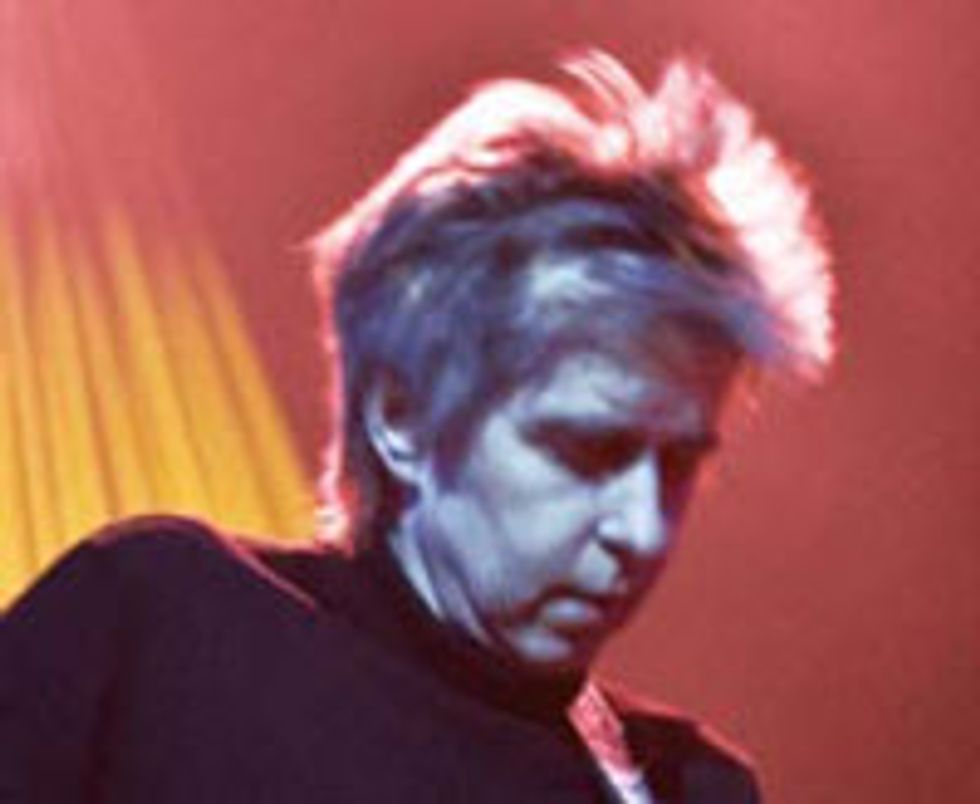
Eric Johnson
Played on “You Are the State,” loaned Noy his studio for the Austin sessions
“We had a day off on tour in New York, and I went down to the Bitter End to hear him. I had heard
his record and I wanted to see this guy live. Then I saw him play in Austin. I sat in with him, he sat in
with me, and we struck up a friendship. I think he has a fresh approach. His chord voicings are unique.
He gets away with atonal stuff, but in a very musical way. He pushes the envelope, but it is intriguingly
palatable. It is pleasing to listen to him play, because you get taken somewhere that is not typical. The
way he uses pedals is a little bent—but what better way to use a pedal? I think that’s what they are for.”
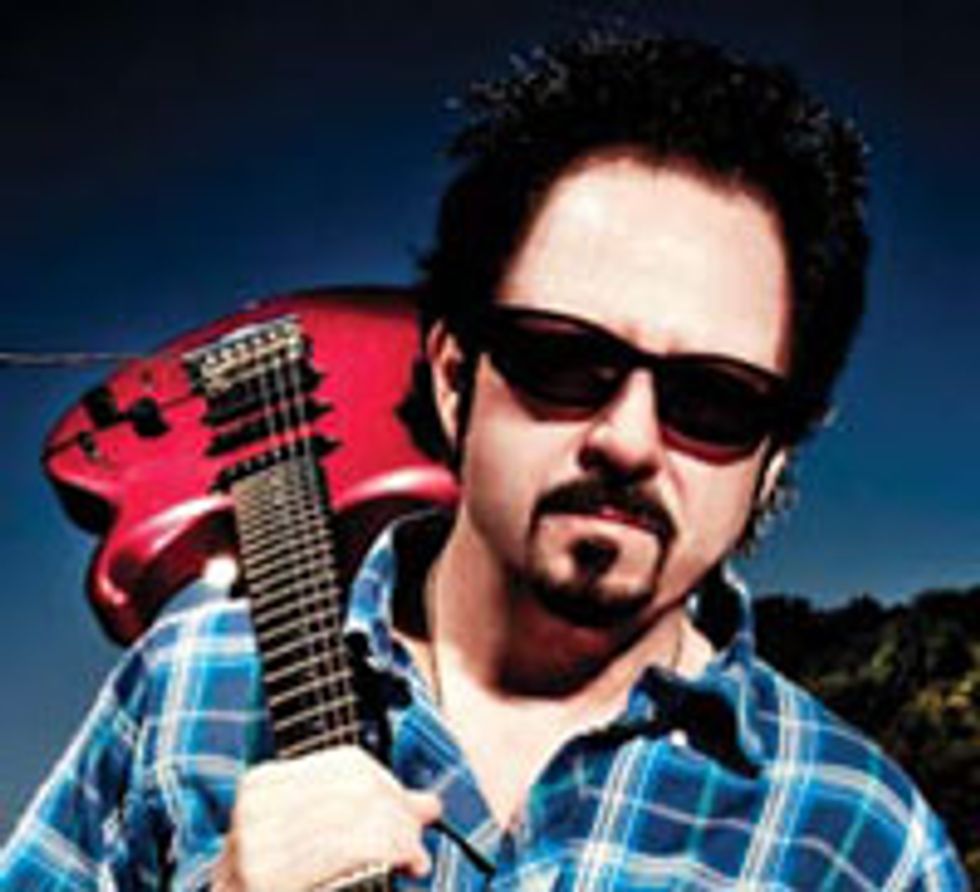
Steve Lukather
Session whiz, Toto guitarist, played on Noy’s 2009 album, Schizophrenic
“I first saw Oz when my dear pal Will Lee invited me to a gig. I was blown away. He has such a unique
approach, not only playing-wise, but sonically—his use of effects, etc. I found him to be an amazing
player, but in a really cool, quirky way. We have become friends, and I am a fan. He asked me to play
some ‘rock guitar’—which cracked me up—on his last CD, a sort of ‘Beat It’ riff like I played on the
Michael Jackson original. It was a quick overdub. Oz knew what he wanted out of me and certainly
did not need me. We had some laughs and I loved doing it. He is a monster player who deserves his
success from hard work and a God-given talent.”
Will Lee
House bassist on Late Show with David Letterman, first-call session player and singer
“As a writer, Oz keeps evolving from album to album. I first heard him was when Chris Parker handed me a cassette, saying, ‘I’m doing
gigs with this guy, and he’d love it if you would listen to him.’ Back then, it didn’t do it for me. But a year later, Anton Fig came to me
with a newer tape and I was astounded at how Oz’s writing had progressed. At that point, I was interested and started doing gigs with him.
We’ve been playing ever since. As a guitarist, he is as good at playing pop music as he is at jazz and blues. His writing is rooted in any and
all of the above. I always have a blast playing with Oz!”
Roscoe Beck
Session bassist (Eric Johnson, Robben Ford)
“Oz is an original—a very distinctive guitarist. He combines just about every element I’ve ever heard. Apart from his obvious abilities as a
soloist, his rhythmic feel is fantastic—[and it’s] all done with a sense of humor. He’s an absolute joy to play with.”
Youtube It
Witness Oz Noy’s slithering, funky rhythms, off-the-wall
phrasing, and wacky effects use in action on YouTube.
Noy, Lee, and Weckl get into some serious grooves, and
then at the 4:45 mark Noy whips up some wickedly warped
loops with his Line 6 M9.
Armed with his sunburst Custom Shop Strat, Noy conjures
hauntingly beautiful voicings punctuated with Lenny
Breau-style harmonics.
At this 2009 date at the Saxon Pub in Austin, Texas, Noy is
joined onstage by Eric Johnson, Anton Fig, and Roscoe Beck
for a funk-jazz rendition of “Schizophrenic.”
Oz Noy's Gear
Guitars
Two Fender Custom Shop 1968 Relic
Stratocasters, Fender Custom Shop 1958
Telecaster, Gibson Les Paul
Effects
Vox wah-wah,Dunlop Jimi Hendrix
Octavia, Xotic AC Booster, Ibanez TS808
Tube Screamer, E.W.S. Fuzzy Drive, DLS
RotoSIM, Hugh & Kettner Rotosphere,
MXR Phase 90, Monster Effects Swamp-
Thang, Fulltone Mini DejáVibe, three Boss
DD-7 Digital Delays, Electro-Harmonix
Memory Man, Line 6 M9
Amps
1967 Fender Bandmaster driving a Bad
Cat 2x12 with Celestion Vintage 30s, 1973
50-watt Marshall head driving a Bad Cat
4x12 with Celestion Greenbacks
Strings and Picks
D’Addarios gauged .012, .014, .018, .028,
.038, .048 for standard tuning, D’Addario
.012 sets with a .049 on bottom (half-stepdown
tuning), Jim Dunlop 2 mm picks
OTHERS ON OZ
Oz Noy is fortunate enough to get the support of players who are more likely to work with high-paying legends than up-and-comers on a budget. In addition to the A-list players on Twisted Blues, Vol. 1—including Eric Johnson, Chris Layton, Roscoe Beck, Reese Wynans, Vinnie Colaiuta, Anton Fig, Will Lee, John Medeski, and Allen Toussaint—his trio has included drummers Dave Weckl (Chick Corea) and Mike Clark (Herbie Hancock), and bassists Jimmie Johnson (James Taylor, Allan Holdsworth) and James Genus (Michael Brecker, Herbie Hancock). We asked some of the players who’ve shared the stage and studio with Noy to talk about what lures them into working with him.

Keith Carlock
Session drummer (Steely Dan, Sting, Wayne Krantz)
“Oz and I moved to New York City around the same time in the late ’90s and met on the downtown
scene. We had similar influences, so we connected right away. He plays so effortlessly and makes it look
so easy, but what is coming out is truly innovative. He always has a specific drum groove in mind, so
he can be specific with what he wants, but then there are usually more open solo sections. Even when
he covers a tune, it’s got that unusual Oz stamp on it. He’s super creative and one of the guitar players
out there doing something truly unique.”

Eric Johnson
Played on “You Are the State,” loaned Noy his studio for the Austin sessions
“We had a day off on tour in New York, and I went down to the Bitter End to hear him. I had heard
his record and I wanted to see this guy live. Then I saw him play in Austin. I sat in with him, he sat in
with me, and we struck up a friendship. I think he has a fresh approach. His chord voicings are unique.
He gets away with atonal stuff, but in a very musical way. He pushes the envelope, but it is intriguingly
palatable. It is pleasing to listen to him play, because you get taken somewhere that is not typical. The
way he uses pedals is a little bent—but what better way to use a pedal? I think that’s what they are for.”

Steve Lukather
Session whiz, Toto guitarist, played on Noy’s 2009 album, Schizophrenic
“I first saw Oz when my dear pal Will Lee invited me to a gig. I was blown away. He has such a unique
approach, not only playing-wise, but sonically—his use of effects, etc. I found him to be an amazing
player, but in a really cool, quirky way. We have become friends, and I am a fan. He asked me to play
some ‘rock guitar’—which cracked me up—on his last CD, a sort of ‘Beat It’ riff like I played on the
Michael Jackson original. It was a quick overdub. Oz knew what he wanted out of me and certainly
did not need me. We had some laughs and I loved doing it. He is a monster player who deserves his
success from hard work and a God-given talent.”
Will Lee
House bassist on Late Show with David Letterman, first-call session player and singer
“As a writer, Oz keeps evolving from album to album. I first heard him was when Chris Parker handed me a cassette, saying, ‘I’m doing
gigs with this guy, and he’d love it if you would listen to him.’ Back then, it didn’t do it for me. But a year later, Anton Fig came to me
with a newer tape and I was astounded at how Oz’s writing had progressed. At that point, I was interested and started doing gigs with him.
We’ve been playing ever since. As a guitarist, he is as good at playing pop music as he is at jazz and blues. His writing is rooted in any and
all of the above. I always have a blast playing with Oz!”
Roscoe Beck
Session bassist (Eric Johnson, Robben Ford)
“Oz is an original—a very distinctive guitarist. He combines just about every element I’ve ever heard. Apart from his obvious abilities as a
soloist, his rhythmic feel is fantastic—[and it’s] all done with a sense of humor. He’s an absolute joy to play with.”
Youtube It
Witness Oz Noy’s slithering, funky rhythms, off-the-wall
phrasing, and wacky effects use in action on YouTube.
Noy, Lee, and Weckl get into some serious grooves, and
then at the 4:45 mark Noy whips up some wickedly warped
loops with his Line 6 M9.
Armed with his sunburst Custom Shop Strat, Noy conjures
hauntingly beautiful voicings punctuated with Lenny
Breau-style harmonics.
At this 2009 date at the Saxon Pub in Austin, Texas, Noy is
joined onstage by Eric Johnson, Anton Fig, and Roscoe Beck
for a funk-jazz rendition of “Schizophrenic.”



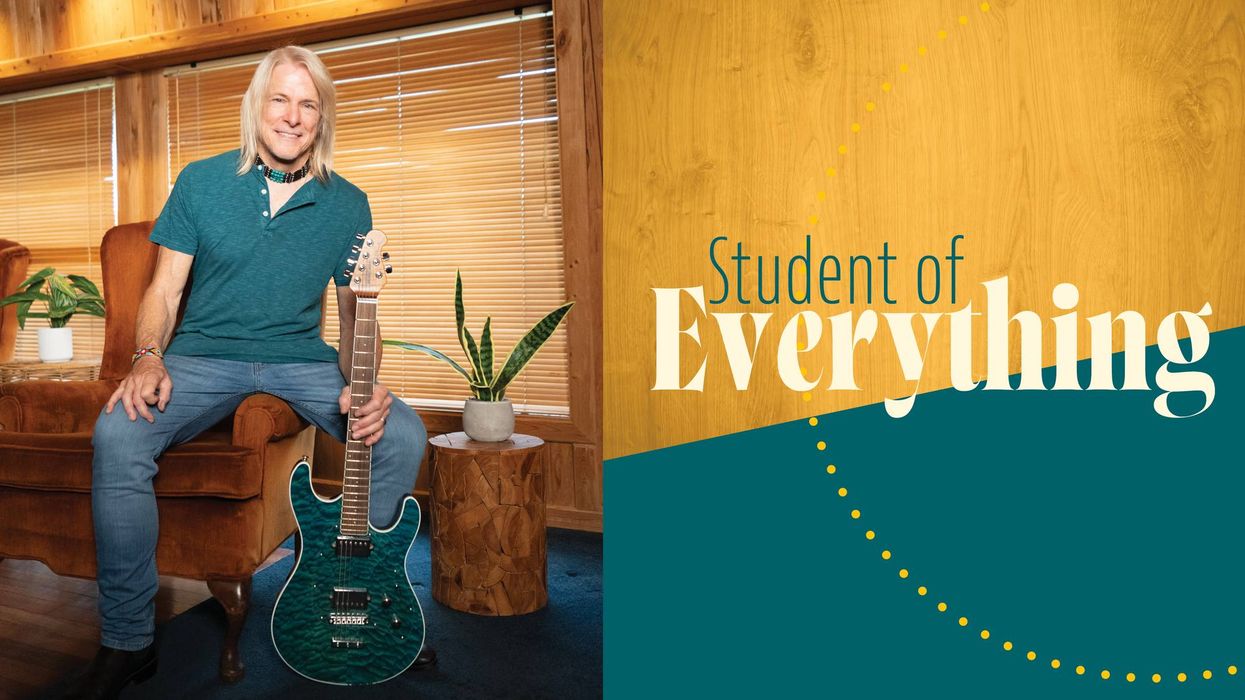



![Rig Rundown: Russian Circles’ Mike Sullivan [2025]](https://www.premierguitar.com/media-library/youtube.jpg?id=62303631&width=1245&height=700&quality=70&coordinates=0%2C0%2C0%2C0)

































